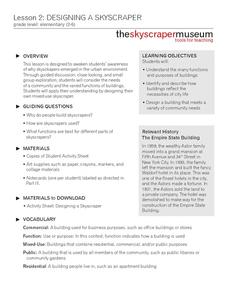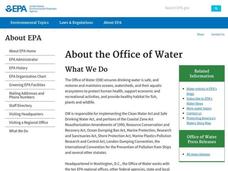Curated OER
Workshop 6: Improving the Community
Students participate in a service learning project to improve their community. They work together to decide on a project and how to implement it. They propose solutions to problems the community is facing as well.
Curated OER
How Typical or Atypical is Your Community?
Young scholars analyze and answer specific questions posed by the teacher about their community. They assess how typical a community is by comparing its characteristics to those of the whole nation. They determine how typical or...
Curated OER
Learning About My Community
Third graders examine maps of their community and discuss how it has changed over time. They identify natural resources and how the layout of their community is important to using those resources. They use the four cardinal directions.
Curated OER
Social Studies Word Cards
For this social studies worksheet, students cut apart 50 word cards. All have words which pertain to citizenship and living in a community. There are no definitions provided.
Curated OER
What are the Rules?
Get young learners involved in the development of classroom rules! Students and the teacher discuss the purpose of having rules, including how rules provide order, security and safety. Then learners design pictures to accompany the...
Curated OER
Wildflower Beautification Project
Students, in cooperative groups, design and create a wildflower garden for the community. They write letters to property owners requesting use of their land and then write invitations to their parents and to local, state, and federal...
Curated OER
All About Our Town
Pupils explore brochure writing. They work in groups to brainstorm and categorize important places in their community. In addition, they gather information from the Internet, take pictures using a digital camera, and create a community...
Curated OER
The Land and People Before Columbus
The major pre-Columbian settlements are studied in this excellente social studies lesson. Fifth graders explain how geography and climate influenced the way various nations lived and adjusted to the environment, and focus on eight...
Skyscraper Museum
Designing a Skyscraper
Besides serving as awe-inspiring monuments of human achievement, skyscrapers are built to perform a wide range of functions in urban communities. The second lesson in this series begins by exploring the history of the Empire State...
Macmillan Education
Christmas: #SadTree
Christmas trees can be as large and elaborate as the tree in Rockefeller Center, or as small and understated as Charlie Brown's tree in A Charlie Brown Christmas. But where did the tradition of Christmas trees come from? An engaging...
Curated OER
A Tale of Two Towns
Students compare and contrast their own community to other communities. They fill out a questionnaire and e-mail it to e-pals in other communities, take digital pictures of important places in their town, and compare them to pictures...
Curated OER
Canadian Landscapes
Ninth graders compare landscapes in their own community to landscapes in other Canadian communities. They discuss how the environment affects the identity of a given community / country.
Curated OER
Big Things: Public Symbols in Canada
Eighth graders explore the concept of regional diversity. They examine factors that influence perceptions of identity at the level of community, region, and nation. They contemplate representation issues with respect to challenging...
Curated OER
A Tale of Two Towns
Learners compare their community and region with other communities around the world. In small groups they complete a questionnaire about life in their community and correspond with e-pals, take digital pictures, conduct research on...
Curated OER
Immigration Unit
Third graders develop an appreciate for the various cultures that are present in their local community. Through reading and research, they explain how various culture came to live in their area. At the conclusion of the unit, 3rd...
Curated OER
Tears of Joy Theatre Presents Anansi the Spider
Accompany the African folktale, Anansi the Spider, with a collection of five lessons, each equipped with supplemental activities. Lessons offer multidisciplinary reinforcement in English language arts, social studies, science, and arts...
Curated OER
Turning the Tide on Trash: Marine Debris Curriculum
Six different lessons comprise this unit on marine debris. Science, language arts, social studies, and art projects make this an ideal interdisciplinary unit. The result will be well-informed future citizens who can help make a...
Curated OER
Landforms
Students study how landforms affect all aspects of a community. Students work in groups to identify landforms from other works of art. In cooperative groups Students select a work of art depicting a particular land form and create a poem.
Curated OER
Maps and Models
Students study maps of New Mexico examining settlement patterns over time and the location of water sources. They research the history of their community and discover how cultural groups interacted, adapted to their physical...
Curated OER
Government
Second graders run for various offices. They dress up like a politician, pretend to be running for an office, and tell the students why they should vote for him/her. They explain why it is necessary for a community to have a government
Curated OER
Local Leaders
Second graders recognize the importance of having community leaders. In this community leaders lesson, 2nd graders find local leader names and local leader news items. Students answer questions and create a graphic organizer about a...
Curated OER
Plan a Park
Students think about designing and, perhaps, creating their own public park or space. It helps students think about community needs, park design, and civic activism.
Curated OER
Making a Bird's Eye-View
Students explore the bird's-eye views on the Texas Bird's-Eye Views website, and discuss why the views were created. They design and create a bird's-eye view of their classroom, school, or community.
Curated OER
Documents of Diversity
Eighth graders explore the cultural diversity in their own families. They examine the cultural profile and historical development of their own community through developing a walking tour, in booklet or web-based form.

























